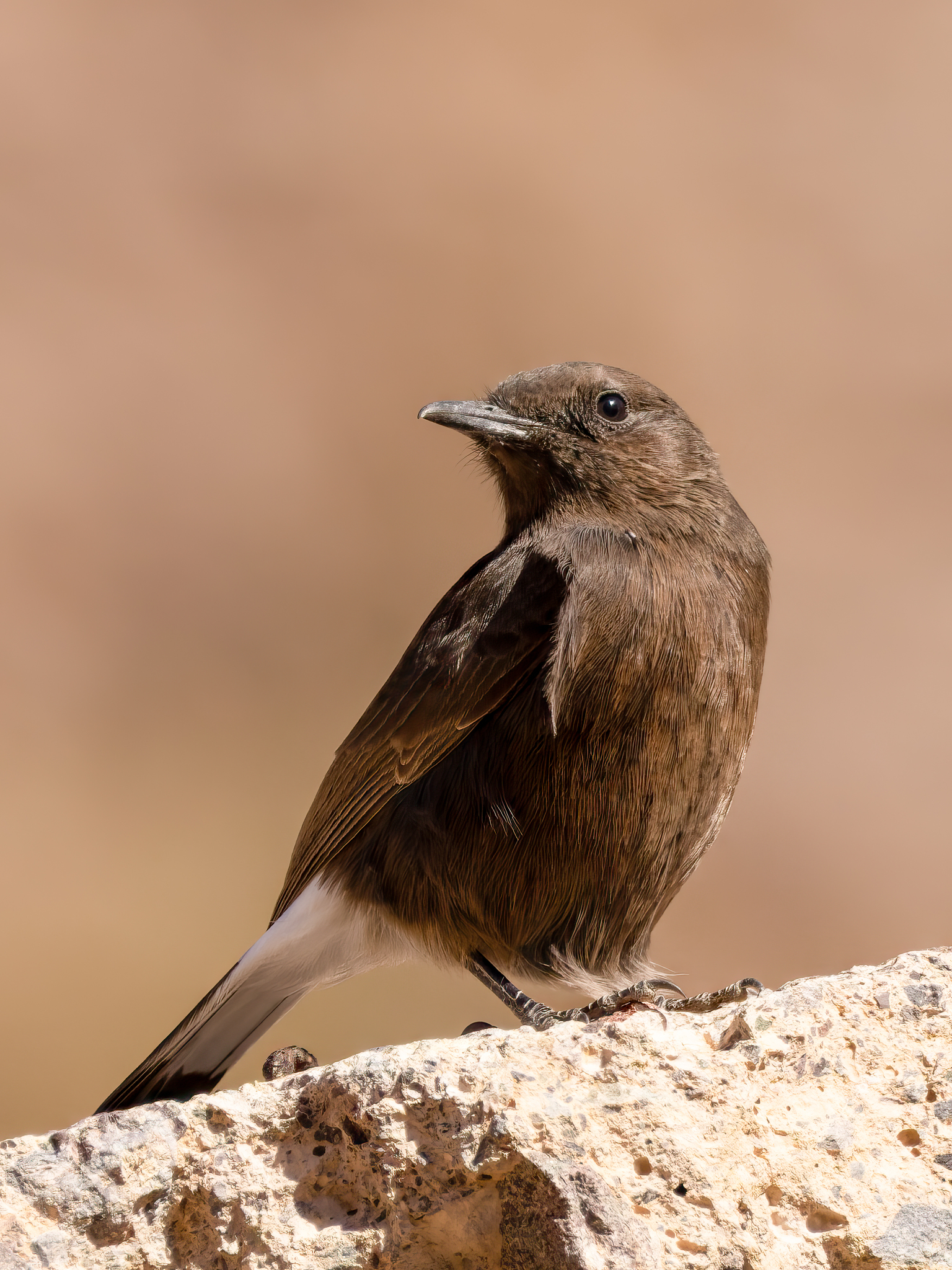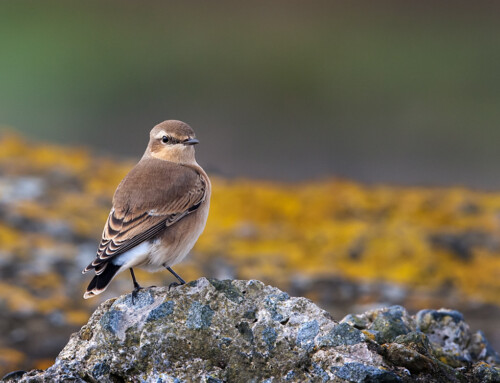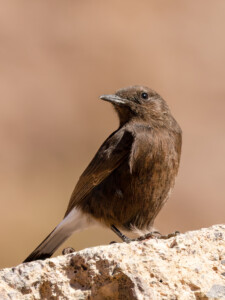
LINKED PAPER
Inferred costs and functional consequences of stone morphometry in the stone-carrying displays of Black Wheatear (Oenanthe leucura). Aznar, F. J. 2023. IBIS. DOI: 10.1111/ibi.13142. VIEW
Courtship behaviour is found in birds around the world, taking various forms including singing, mate-feeding, and mutual preening. Many birds put on elaborate pre-mating and/or post-mating displays which are commonly regarded as forms of sexual selection, with one or both members of the pair using these displays to assess and select potential partners. This process is based on honest signalling, with better displays – which often incur greater costs – being performed by mates of higher quality. However, the costs of displays can be difficult to identify and quantify, which can make it hard for researchers to fully understand the behaviour.
In a recent study in Ibis, Francisco Javier Aznar compared stones from two territory types commonly used by Black Wheatears (Oenanthe leucura) to evaluate the effects of stone morphometry on male stone-carrying displays.
Black Wheatear stone-carrying displays
Black Wheatears are a small, monogamous passerine resident in arid regions of the Iberian Peninsula and North Africa. While female Black Wheatears carry flat stones to use for nest construction, which is also common in closely related species of wheatear, this species is unique as males also carry stones from an area 2–10m away from the nest before each breeding attempt (Moreno et al. 1994). In fact, the males carry over six times more stones than the females and these form visible piles when nesting places are re-used over multiple years (Figure 1). As this male stone-carrying occurs after copulation, only when females are present, and appears to result in an adjustment in female reproductive effort (Moreno et al. 1994, Soler et al. 1996), this behaviour has been interpreted as a post-mating sexual display. There is also evidence that it represents an honest signal of male quality, as the total number of stones carried is positively correlated with male feeding rate of nestlings (Moreno et al. 1994), the average weight of carried stones is positively correlated with male immunocompetence status (Soler et al. 1999), and the total number and mass of carried stones is negatively correlated with wing loading (i.e. body mass divided by total wing area) (Møller et al. 1995). One aspect of stones which has not been previously measured is the mechanical costs on males in terms of neck and bill torques and outward-pushing forces, which partly depend on the stone morphometry.
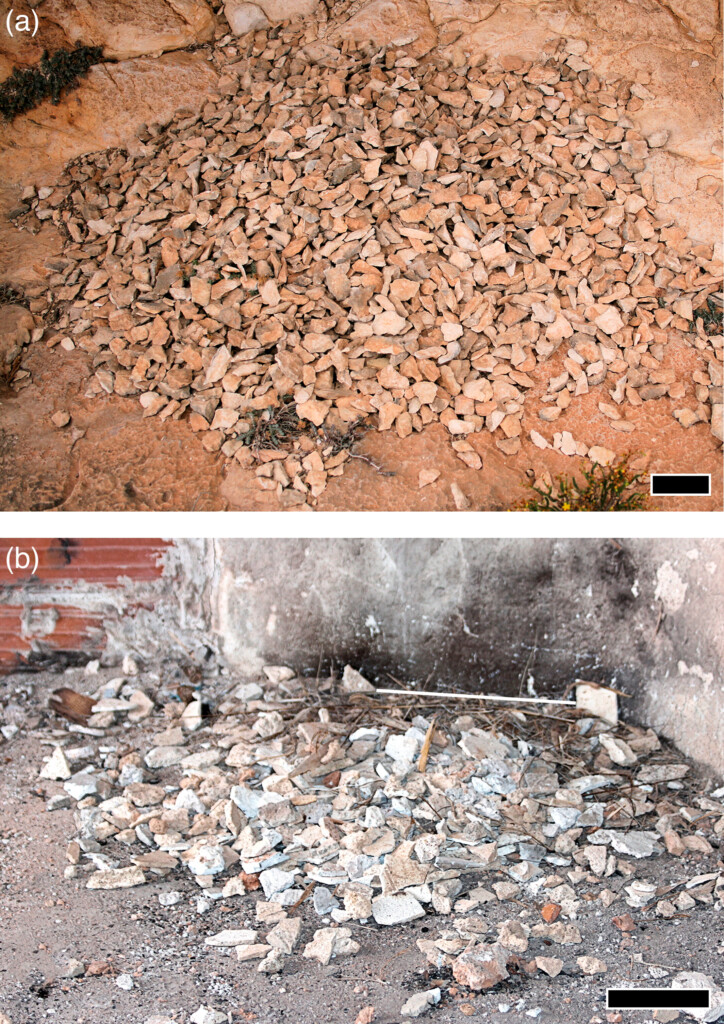
Figure 1. Piles of stones carried by male Black Wheatears Oenanthe leucura to breeding territories during courtship displays. (a) In a limestone rock outcrop (‘rocky’ territory). (b) Inside an abandoned building (‘building’ territory). Scale bar: 10 cm.
In this study, stones from two types of Black Wheatear nesting territories in southeastern Spain were compared: limestone outcrops (‘rocky’ territories) and old human habitations (‘building’ territories). In the building territories, the only available ‘stones’ are fragments of gypsum or limestone plaster which are potentially less dense than the limestone rocks available in the rocky territories.
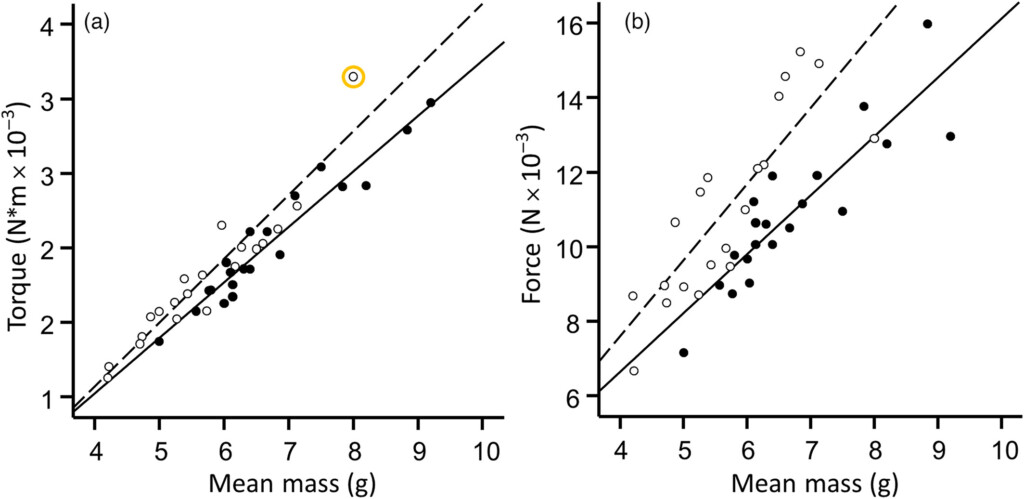
Figure 2. Mechanical costs, for a given mass, associated with differences of morphometry of display stones carried by male Black Wheatears Oenanthe leucura in 20 territories located in rock outcrops (‘rocky’ territories; solid dots, solid line) and 20 in abandoned buildings (‘building’ territories; empty dots, dashed lines). (a) Torque effects produced by the stone on both the bill and the centre of gravity of the body. Note that the relationship did not change when removing the territory encircled in orange. (b) Outward force that tends to push the stone out of the mouth.
Morphometry impacts stone selection
The results of the study showed that, in both territories, stones used in displays were significantly thinner and generated higher estimated torques, but lower outward-pushing forces, than stones which were available but not chosen for use in displays. Comparing between the territories revealed that display stones in the building territories were thicker but had significantly lower mass than those in the rocky territories, meaning that the transport costs of display stones were similar between the territory types.
Overall, the results strongly suggest that both stone morphometry and stone mass impact the stones chosen by male Black Wheatears for post-mating displays, and that stones were not collected randomly. They also indicate that the males may have more difficulty selecting stones they can handle within the limits of availability in abandoned houses, because many of the stones available have too great a volume. It is suggested that further experimental research on male performance and the cues that females use to assess the displays would be useful to expand and enrich the findings of this study, and that a broader conceptual framework would be necessary to address the consequences, both behavioural and morphological, of carrying rigid objects with the bill.
References
Møller, A.P., Lindén, M., Soler, J.J., Soler, M. & Moreno, J. (1995). Morphological adaptations to an extreme sexual display, stone carrying in the black wheatear, Oenanthe leucura. Behavioral Ecology 6: 368-375. VIEW
Moreno, J., Soler, M., Møller, A.P. & Lindén, M. (1994). The function of stone carrying in the Black Wheatear, Oenanthe leucura. Animal Behaviour 47: 1297-1309. VIEW
Soler, M., Soler, J.J., Møller, A.P., Moreno, J. & Lindén, M. (1996). The functional significance of sexual display: Stone carrying in the black wheatear. Animal Behaviour 51: 247-254. VIEW
Soler, M., Martín-Vivaldi, M., Marín, J.M. & Møller, A.P. (1999). Weight lifting and health status in the black wheatear. Behavioral Ecology 10: 281–286. VIEW
Image credits
Top right: Black Wheatear (Oenanthe leucura) | William Stephens | CC BY 4.0 Wikimedia Commons
Blog posts express the views of the individual author(s) and not those of the BOU.
If you want to write about your research in #theBOUblog, then please see here


